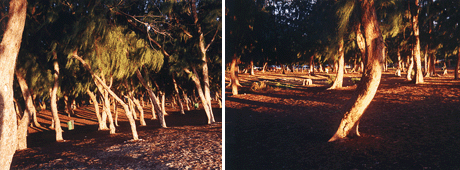Traveling all the way to la Rnion, an island in the Indian Ocean, Jean Detheux discovers a remote location struggling to join the technology revolution and raising questions about our rampant globalization.

The Fourth Crossroads of the e-mage of the Indian Ocean (4ème Carrefour de l'e-mage de l'Océan Indien) was held from January 29 to February 2, 2001, on Reunion Island. This island is situated 500 miles off the east coast of Madagascar, but is a genuine European region, part of France, in the Indian Ocean! (A "DOM" -- a "département d'outre-mer" -- as the French call it, an overseas district.) The population is about 730,000 inhabitants, and the island enjoys the typical infrastructures found in most European regions.
Arriving there, one is struck by a strange sense of "déjà vu;" one knows the plane left Paris 11 hours ago, yet one could have landed somewhere on the outskirts of Nice! The cars are the same (North Americans miss a lot in not having access to all those terrific small compact Peugeot, Renault, Citroën, VW, Fiat, Lancia and other well designed, well made, attractive and efficient models), the road marks are the same, even the billboards and houses seem -- almost -- similar. Yet, if there are strong similarities between Saint-Denis de la Réunion and a generic Southern French city, there are also striking differences: first, at this time of year (summer "down there"), the heat can be overwhelming, especially if it comes with the humidity only the monsoon regions can produce. The plants are different too, and if one has a chance to step out of the car and listen, the bird sounds are unmistakably "tropical."
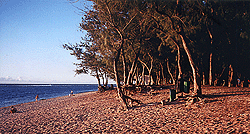
La Réunion's beach, late afternoon. All photos courtesy of Jean Detheux.
Yet, this is Europe, and France.
A Unique Status
Being part of France and Europe, la Réunion benefits from some formidable aid programmes; programmes that could make the difference between a remote "third world" status and a vibrant "first world" economy opened to the new technologies. The decision-makers of la Réunion have decided to invest heavily in the new technologies and are extremely pro-active in trying to create the kind of infrastructure and economy that could take the island out of its present state -- suffering from between 40 and 50% unemployment -- and usher it into the new millennium.
In place for several years, the strategy is focused on a two pronged approach: develop the infrastructures (including lines of communication) while training the local labour force so that they can sustain and meet the needs that the new technologies bring to the island, and find and bring home all the possible forms of help which can be used to attract potential investors. In this regard, Europe, France and la Réunion can pack quite an attractive punch designed to lure (in the good sense of the term) those looking for new places to do business in animation cinema and fiction cinema production.
The island has already shown that it can meet the demanding standards of CD-ROM production and 2D animation. It is now aiming its sites at 3D animation, Web technologies and fiction cinema, with substantial aid for partial financing of local productions now available. La Réunion has some absolutely smashing and varied landscapes (from tropical shores through strange alpine meadows all the way to moon-like volcanic craters) which ought to attract companies looking for unusual shooting locations (the light too is quite unique).
The local workforce (50% of the island's population is under 25 years old!) has access to a variety of high quality education channels in new technologies, IT and communications, including the artistic education provided by the "école supérieure des beaux-arts et des métiers artistiques de la Réunion" (superior school of fine-arts and artistic trades of la Réunion) and the Institut de l'Image de l'Océan Indien (ILOI or Image Institue of the Indian Ocean).
One potential weak link in this chain could be the connection between the island and the rest of the world, but at the time of writing, there are serious efforts being made to remedy that. ADSL is increasingly available, and the fiber optics cable "SAFE" (South Africa Far East) is being brought in from South Africa. The island itself is already extensively wired, so this major problem is being addressed by people who are only too aware of the importance of the pipes.

Views of Piton de la Fournaise, a basaltic shield volcano that forms the southeast half of Réunion Island.
Rather than going through a lengthy listing of all the aid programmes available to investors, I will refer the reader to the "Comité de Pilotage de l'Industrie" ("CPI," the industry steering committee) and its "chargé de mission," Mr. Paul Hibon, who can be reached via email at: cpirun@guetali.fr; phone: 02 62 922492; fax: 02 62 922488; and URL: http://wwwcpi.asso.fr. Many of these programmes can actually cover 50% or more of all production costs and can be applied over time to many aspects of those costs, including capital costs, taxes, labour costs and much more.
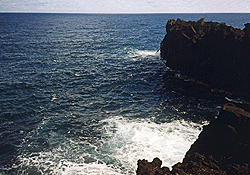
The rocky cliff shore of Cap Méchant or Mean Cape.
All the Island Offers
The Crossroads conference started with a presentation by representatives from the State, Region and CNC (National Cinematographic Centre) on the following theme: "La Réunion, land of production and fabrication of animation cinema." This presentation stressed the immense commonality of the efforts brought to Réunion by the different levels of government. It served as a strong reminder that the island is a part of Europe and France, and reflected the European approach of helping regions, something we North Americans may want to reflect upon. (Should we just "dump" less productive/fortunate regions, or help develop them with public moneys?)
Another question pertinent to North American projects was asked during this presentation: "Can all this financial help apply to projects that would not be realized in French?" The answer was twofold: "As of right now, the regulations are such that much of the help applies to productions made in French. However, if such a project (non-French) ever surfaces, we can guarantee you that whatever is needed will be done to make it viable and eligible to the same financial help as are the French language based projects." I want to emphasize the strong sense of "can do" attitude exuded by those in decision-making positions, something quite unlike much of the European bureaucratic "red tape" and hurdles with which this person is only too familiar.
This was followed by a delightful lunch served buffet-style under tents along the harbour ("Le Port"). Many participants took advantage of this opportunity to meet one another. The food was remarkable; a mixture of Indian ("cari" as in curry, "Massalé" as in Massala), Créole ("boudin," sausage), French (Bordeaux and Beaujolais wines, pastries), local rum, including "rhum arrangé," a rum in which herbs and spices have been steeped, and exotic fruits. I ate the very best mango ever. "Mangue Joseph" is a small, roundish fruit, very different from the usual oval fruit that I was familiar with, and a source of unbelievably deep and long lasting flavours.
That same evening, we were invited to a party where Pipangaï celebrated its fifth anniversary. Pipangaï, the second largest European animation studio (in production volume), can deliver up to fifteen half-hour 2D animations per month. The studio has already produced in excess of 300 half-hour animated episodes sold in over 80 countries. It specializes in colorization, background painting and compositing -- basically, catering to the needs of animation studios in need of qualified yet affordable labour.

Alain Séraphine participating in an intense discussion.
During this party, Alain Séraphine passed the torch to Azmina Goulamaly, now the new director of Pipangaï. Séraphine will focus his formidable energy and talents on the ILOI (Indian Ocean Institute of the Image), an institute that, along with the School of Fine Arts, could do much to not only develop local qualified labour, but also set the scene for the emergence of genuine local talent and vision (something that could go a long way toward lessening the dependence of la Réunion on projects from abroad).
Cyberspace, Pipangaï and Movies
The next day started with a review of e-learning, e-commerce and communications both on the Internet and Intranet as seen from a French perspective. The moderator was Gérard Cauvain of Les Gobelins (http://www.gobelins.fr/public/index.html), a well-known school of multimedia (photography, animation cinema, design, video, multimedia) in Paris. The Gobelins in general, and Gérard Cauvain in particular, have a lot to do with what is now happening on Réunion. They take part in the training being offered by ILOI and, as the Gobelins is in the forefront of "continuing education," it is a natural for responding appropriately to the unique needs of such remote areas.
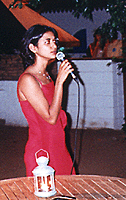
Azmina Goulamaly, the new Pipangaï director.
Among the presentations, two individuals talked about Intranet communications and new technologies (Arnaud Lacaze Masmonteil, instructor at les Gobelins, and CEO of www.infotronique.fr) and the stakes of e-commerce (Julien Dufour, graduate of les Gobelins). What was immediately obvious were the differences in situation between France and North America. Figures showed that the percentage of the population now wired is a lot less in France than in the U.S. and Canada, but even more significant, were the percentages of those who are wired and trust on-line transactions. I would have thought that France, with its Minitel network (see http://www.minitel.fr) had a head start in entering the Web age, especially as far as e-commerce is concerned, but it does not yet seem to be the case. What I also noticed however was that these two young French IT specialists demonstrated not only a thorough knowledge of their field, but also a well rounded "general culture" as evidenced by their many references to things outside the narrow confines of their concentration. (I don't know too many North American "geeks" who could intelligently discuss the relative merits of L.-F. Céline's early and late works!)
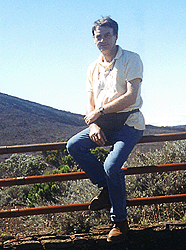
Gérard Cauvain of Les Gobelins, France's leading animation school.
Later that day we visited Pipangaï and were given a tour of the building. We saw all the usual trappings of such institutions, with many young islanders busy working on current projects. SGI computers were everywhere, and there was a focused yet relaxed atmosphere, a feel of quiet confidence.
That evening, Georges Lacroix was given "carte blanche" to create and present a screening of his choice. Georges is a formidable figure in French animation. He's been a visible player in much of French media from illustration to art direction. He was artistic director at L'Express, a French magazine, from 1973 to 1980 and created Fantôme, an animation studio specializing in digital 3D images. (Fantôme was later purchased by Neurones, now Neuroplanet, only to be cannibalized so it seems.) Georges had his hand in many award-winning animation movies, with Fables Géométriques and Insektors being the better known examples. His present focus seems to be mostly on organizing international conferences dealing with new technologies pertaining to the art of animation. He's done work for the Annecy animation festival amongst others. He also teaches directing at the Angoulême Cartoons National Centre (Centre National de la Bande Dessinée d'Angoulême) and at Réunion's ILOI. The evening was an opportunity to see one man's selection of many animated pieces reflecting his experience, his tastes and giving us a glimpse of what makes him tick.
Georges put together a long programme, which included the works of Tex Avery, Tim Burton, Michaël Dudok de Wit, Yuri Norstein (that Hedgehog in the Fog poetic masterpiece), a collection of Pixar shorts (Geri's Game, For the Birds, etc.) and much more.

Georges Lacroix relaxes after a long day!
He also decided to show samples of the ILOI's recent interns' work. This was, for me, a bit of an eye opener as it showed that, technically, these kids had nothing about which to envy their North American counterparts. However, I could not help notice (and I was not the only one) that there was one big factor absent in all the pieces we saw: no trace or sense of what the French call "le terroir." It is hard to translate, but it is something like, "a taste of the local/native soil." There was no presence of the Indian Ocean in general and of Réunion in particular. This, of course, reflects yet another personal opinion, but I wonder if "globalization" isn't having a homogenizing effect on places even as far away as Réunion. These short animated films could indeed have been made anywhere!
The New Technologies
Friday was a different day all together. We were treated to a succession of intense sessions, most of which dealt with the theme "New Tools for New Concepts."
Eric Bessone and Pierre Maréchal of Sensable Technologies (http://www.3d-touch.com/) demonstrated FreeForm (http://www.3d-touch.com/FreeForm/index.htm), which through its touch sensitive arm/tool makes it possible to model virtual clay in real-time, while receiving tactile feedback from the work via the tool. This makes it possible to work on virtual clay through both visual and tactile senses, with almost no learning curve (if one is already familiar with clay/foam modeling). Quite a trip! One can even enter the clay piece and work on it from the inside. A selection of keyboard commands makes it a breeze to change the size of the tool tip and more. This was a hit with many people; they just had to have their hands on it.
After that, Jane White of Protozoa (http://www.protozoa.com/) gave us a virtual tour of the studio, including footage of their work with Sesame Street (as in Elmo interacting with "live furniture" through the motion-capture of foam rubber pieces being manipulated). There was quite a bit of time spent on motion-capture and how Protozoa and DotComix, a sister company, use this procedure. The examples presented seemed to show that if motion-capture -- as is -- may have had its day, it may now have hit a wall of sorts. If animation is art (that could be an open question), then surely it must deal with transposition (you know, "art is what makes us see" or "it is the lie that makes reality more real"). Motion-capture seems to have fallen for the literal, bypassing/avoiding that transposition all together.
DotComix especially seems to bring to my mind questions about the differences between entertainment and art; a recurring theme for me during this and other such events. I keep running into a question that could be phrased this way: "Isn't it time to choose between South Park and Rembrandt?" And I don't agree with those who say that we now can have both. I believe we can have "something" when we try to have both, but both "it ain't!"
The predominantly French audience seemed to respond favorably to the offerings from DotComix. I however noticed that, for most of them, the deeper content of (for example) Duke 2000 was totally absent. The French can often project a lot of meaning (or miss it all together) in all things "American" (need I say, "Jerry Lewis?"). I asked pointed questions to several members of the audience and very few knew of Doonesbury, or even less of what this comic strip represents in terms of the post-Vietnam War American psyche.
Interestingly enough, I see a common thread developing between motion-capture, virtual 3D modeling, 3D animation and the creation of "autonomous virtual humans." They all have to accept, as a given, the a-priori existence of "the world," a world made of solid objects moving in empty space. This is rooted in what Husserlian Phenomenology would call a "naive" world view (not necessarily pejorative), and I believe we already have found many indications that this is far from being a true reflection of our experience of our reality, our "living present."
Later on, Ludovic Duchâteau introduced Virtools (http://www.next-url.com/) and demonstrated how Virtools Creation can bring behavioral 3D authoring to people who have little or no programming background. The Virtools Web Player could be an interesting plug-in for viewing 3D animation on the Web, but it is not yet available for the Mac at the time of writing.
Mendel3D (http://www.mendel3d.com/) was presented as a new set of tools to create and deliver 3D content on the Web. The file sizes these things can reach are amazingly small, something that I am sure will be of interest to many a Webmaster.
On Being Human
We also had our first encounter of the day with Maurice Benayoun (http://www.z-a.net and http://www.benayoun.com/) and the creation of virtual worlds in which both "real" humans and virtual humans can interact. Some of his better known works are The Tunnel Under the Atlantic (Montréal and Paris, 1995), World Skin (Ars Electronica, 1998) and Tunnel Paris/New Delhi (Paris and New Delhi, 1998). This set the tone for what the day would be mostly about, a very serious investigation of the interface between the virtual and the "real." The questions that were brought up during the day, and the way in which they were dealt, set a tone that was quite different from the rest of the event. We were no longer looking passively at presentations of a general nature. We were being challenged by ideas that looked at our very notion of what it is to be "human." The work of Stéphane Donikian (and others such as Daniel Thalmann) forces a deep reflection on the nature of our being.
When the demonstration of how a virtual human is being programmed was made, we went step by step into its makeup. I was hard pressed to find "something" that had not yet been catalogued, and was delighted (relieved?) to come up with this one: consciousness! Our consciousness seems to work a lot by association, so that (as has been shown so well by Herman Hesse) a scent can trigger the vivid recollection of a sound and vice versa. This ability we have to experience as "real" that which is physically not "there" is what the autonomous virtual human has a long way to go to acquire. It is our very subjectivity that may save us from (total) assimilation (yes, a Borg joke).
In a more "practical" way, this type of research opens up doors for applications such as virtual interactive games and remote manipulation, as in surgery or dangerous environments. In this latter field, Jean Noël Portugal has a lot to offer (http://www.dramaera.com/). It is also worth noting that Jean Noël Portugal and Stéphane Donikian share some of their research, which has led to commercial applications such as those offered at http://www.irisa.com.
I felt that these topics, all brought up during the last day of the conference, were important enough to warrant a conference of their own, as much had to be left out due to time constraints.
Larger, Larger, Larger Issues
This was an event that comes back to me in two ways. As a showcase of la Réunion as a good place to do business (in animation and fiction cinema), it was a real success. All the people we dealt with demonstrated an amazing good will and much competence, insuring that their desire and commitment to see this type of industry be established deeper on the island will most likely succeed. I cannot stress enough all the financial benefits potential investors can derive from implanting some or all of their operations, and the value of the enormous amount of benevolence and competence they will for sure meet locally.

The beauty of the alpine meadows.
On the other hand, much of what happened led to reflections about the kind of world we are now busy creating through this rampant globalization. With that in mind, I wonder if la Réunion isn't focusing its sight on too short a vision, aiming at a short term success (as a service industry to the global animation market), but in the process, risking the longer term negative outcome of not developing its own unique content. Asia is quite capable of delivering those services at the lowest possible costs, but it may not be able to deliver truly unique content (unless it too revises its thrust).
In my examining this problem, I see how much it also exists in, for example, North America, a continent were there are many remote areas which, if we stay within the "global" models and agenda, will never be able to compete head on with urban centres. Unless, once again, the remote areas develop their unique and irreplaceable content and, like on la Réunion, they benefit from serious public aid to develop their infrastructure. The Web is exploding and the need for original material is greater than ever. That need can only continue to grow, surely this could provide the incentive to bank on one's idiosyncrasies?
As an example. Montréal was recently given the opportunity to see Passage, a co-production by the Théâtre Talipot (from la Réunion), the Centre Dramatique de l'Océan Indien, the Théâtre de la Ville de Paris and the Théâtre de Saint-Quentin-en-Yveslines. This show was a terrific success in Canada, from where I am writing. Passage is the quest of a man who searches far and wide for his identity and freedom, and who finds it when entering a cave in the very same way one enters one's self. In there, he finds that at his deepest core, he is not alone, far from it. The show was presented in a mixture of French, Créole, Zulu and more. The "idiosyncratic language" was not at all a barrier to comprehension, the "meaning" was felt more than "understood."
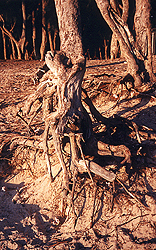
Near a beach on Réunion Island; is this perhaps a "tree of passage?"
Is it possible to find the universal in the particular?
Is it possible for remote areas to develop this respectful relationship with their uniqueness, and in the process make a success of sharing it with the rest of the world? In a very real sense, it belongs to the rest of the world, but aren't we "the rest of the world" to each other?
A few memorable lines from T. S. Eliot's Four Quartets keeps popping into my mind:
We shall not cease from explorationAnd the end of all our exploring Will be to arrive where we started And know the place for the first time.--Little Gidding V, Four Quartets (1943)
Jean Detheux is an artist who, after several decades of dedicated work with natural media, had to switch to digital art due to sudden severe allergies to paint fumes. He is now working on ways to create digital 2D animations that are a continuation of his natural media work. He has been teaching art in Canada and the U.S., and has works in many public and private galleries.
